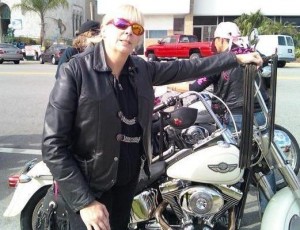Today nearly 25 percent of motorcycle riders in the U.S. is a woman compared with 1990, when only 6 percent were women.
Female motorcycle owners have gone from oddity to commodity.
Women riders aren’t the sideshow anymore. During the recession, the buying power of female bikers is fueling sales and helping to keep bike builders and manufacturers in business.
Today nearly 25 percent of motorcycle riders in the U.S. is a woman compared with 1990, when only 6 percent were women.
That’s more than 6 million women on motorcycles, not only buying bikes, but all the gear, equipment, and accessories to complete the biker look. While the company doesn’t break down the numbers by gender, Harley-Davidson reports total sales of more $4 billion last year.
“Tapping into this market has been absolutely essential for Harley-Davidson, and it has been building with education and enthusiasm,” said Karen Davidson, great-granddaughter of a founder of the manufacturing giant. “The more women who get on bikes, the more other women think they can do it, too. It’s infectious.”
On Tuesday, Davidson led the fourth annual Harley-Davidson Women’s Ride, a popular Bike Week event that included 136 women cruising through Daytona Beach.
Decked out in purple feather boas, or wearing breast-cancer-awareness pink Ribbon Riders jackets, the women roared out of Riverfront Park and up to Destination Daytona, raising more than $31,000 for the Muscular Dystrophy Association.
Elizabeth Pillow, 54, an engineer from Zeeland, Mich., was among the top fundraisers for the event. She rode as a motorcycle passenger for decades. But after her husband died, she bought her own bike in 2009, a Harley-Davidson Softail, just in time for last year’s women’s ride.
“There are more women riding, and the businesses are encouraging women to ride, with these events and with custom features for women,” Pillow said.
Tapping into that market, Harley-Davidson dealerships offer garage parties for women, while Roar Motorcycles for Women, a Daytona Beach company that makes custom motorcycles for women, offers self-defense and empowerment classes. Charity bike rides and specialty shops now host breast-cancer awareness events.
Women have been riding since the early days of motorcycles. Author Susan Hurst chronicled that past in her book, “Women & Motorcycling: The Early Years” in 1991.
Hurst also rode in the fourth annual Harley-Davidson Women’s Ride in Daytona this year with the all-woman’s motorcycle club, Leather & Lace MC. This club was founded by Jennifer Chaffin in 1983 in nearby Edgewater, Florida but now has chapters all over the U.S.
Leather & Lace is unique among women’s motorcycle clubs as it is not a social club or riding club like most women’s clubs. They are a true MC which means women can’t just join and buy a back patch, they must be accepted and earn their three-piece patch which can take years.

Author Susan Hurst, the foremost expert on the history of Women & Motorcycling at the 4th annual Women's Ride in Daytona, Florida.
The oldest women’s motorcycle club, the Motor Maids, was founded in the 1940s. Now there are many Motorcycle Clubs for women only.
In the 1950s, motorcycles went through their “bad boy” phase, and women were relegated to the back of the bike. That’s when manufacturers stopped making motorcycles that a woman could ride, said Kathy Tolleson, CEO and founder of Roar Motorcycles Inc.
Tolleson discovered that problem firsthand, when as a 50-something grandmother, she bought her own motorcycle but struggled to make the clunky cruiser fit her comfortably.
She started Roar Motorcycles to accommodate female bikers.
The handlebars are longer so that women don’t have to reach as far. The fuel tank and seats are narrower, making for a more ergonomic fit. The bikes have a lower center of gravity and are designed so that a woman can lift the motorcycle using leg and hip strength, rather than upper-body strength. The motorcycles can be custom-fit even for a petite woman like Tolleson herself.
Roar Motorcycles premiered in 2008, not long before the economy tanked. But even with the recession, the company’s motorcycles have been sold in 15 states and Canada.
“It hasn’t been easy, but it’s clear that the women’s market will continue to grow,” Tolleson said. “In about 15, 20 years, I think it’ll be more unusual for a woman to be on the back of the bike than behind their own handlebars.”
Both Kathy Tolleson and Susan Hurst were honored by Born To Ride Magazine and TV in their Tribute to Women Riders for their “contributions in the motorcycle industry and the motorcycle community” in May, 2009.
You can read posts from Susan Hurst in the pages of Krazy Biker Katz!

Leave a comment
You must be logged in to post a comment.